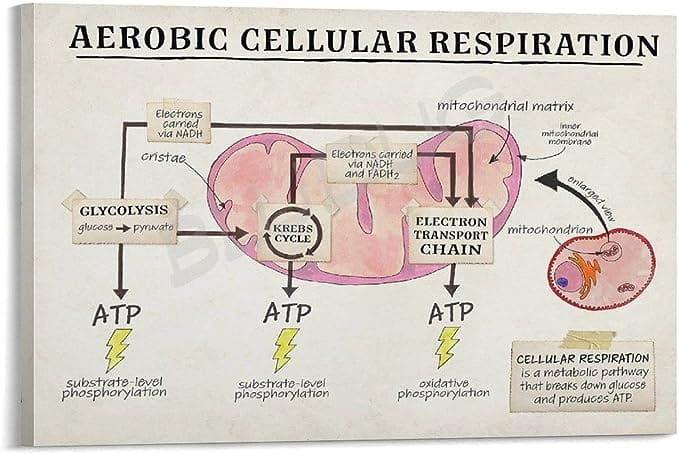Definition
Aerobic respiration is a biological process in which glucose is broken down in the presence of oxygen to produce energy, carbon dioxide, and water.
Expanded Explanation
During aerobic respiration, organisms convert energy present in the bonds of glucose into Adenosine Triphosphate (ATP), the “energy currency” of cells. This process involves a series of chemical reactions and occurs in the mitochondria of cells.
Importance
Aerobic respiration is fundamental to life as it provides the energy required for various biological functions, including growth, reproduction, and maintenance of cellular structures. It’s critical in both unicellular and multicellular organisms.
Context and Usage
In biology, the term ‘aerobic respiration’ is used to describe the energy-producing process in cells. In exercise science, it refers to the body’s use of oxygen to meet energy demands during exercise.
Examples
- Example 1: In humans, aerobic respiration occurs constantly to fulfill energy needs, with the rate increasing during physical activity.
- Example 2: In yeast, aerobic respiration results in the production of carbon dioxide and ethanol, a process used in baking and brewing.
Understanding Aerobic Respiration
A common misconception is that aerobic respiration only occurs during exercise. In fact, it is a continuous process in all oxygen-breathing organisms, though the rate varies with energy demand.
Related Glossary Terms
- Cellular Respiration: A broader term encompassing both aerobic and anaerobic (without oxygen) processes that convert biochemical energy into ATP.
- Mitochondria: The organelles in eukaryotic cells where aerobic respiration occurs.
Visual and Reading Aids
External Resources
- Khan Academy – Cellular Respiration: Khan Academy’s resource on cellular respiration provides detailed, easy-to-understand content on aerobic respiration. It covers the process’s mechanics, including glycolysis, the citric acid cycle, and oxidative phosphorylation, supplemented with instructive videos and quizzes.
- BBC Bitesize – Aerobic and anaerobic exercise: This article discusses the differences between aerobic (with oxygen) and anaerobic (without oxygen) exercise. It specifically details the anaerobic respiratory system, which provides quick energy for short-duration, high-intensity activities, such as gymnastics vaulting or javelin throwing. This system breaks down glucose into lactic acid, supplying energy rapidly. However, lactic acid is a fatiguing by-product, causing muscle discomfort and pain. The article also introduces the concept of oxygen debt, which is the additional oxygen needed post-exercise to break down lactic acid and replenish the creatine phosphate stores.
Related Articles
- Unleash Energy: How Thermic Effect of Food Protein Transforms Your Diet: Discusses the role of energy from aerobic respiration in metabolism.
- Your Basal Metabolic Rate Is a Secret to Your Ultimate Health: Explains how energy production through aerobic respiration affects basal metabolic rate.

